Performance Enhancement of a Partially Shaded Photovoltaic Array by Optimal Reconfiguration and Current Injection Schemes
Abstract
:1. Introduction
2. PV Model and Impact of Partial Shading
2.1. PV Model
2.2. Partial Shading and Its Effects
3. Optimal Reconfiguration and Proposed Half-Bridge Current Injection Scheme
3.1. Optimal Reconfiguration
3.2. Implementation of the HBCI Scheme
- Step 1: Measure the current and voltage from the 4 × 4 SP array and calculate the power of the PV array as shown in Figure 7a. If power is reduced, then
- Step 2: Calculate the column current of each PV string.
- Step 3: Identify the columns that have the highest and lowest currents.
- Step 4: Each of the strings is subdivided into two parts and the whole array is divided into eight parts as shown in Figure 7b.
- Step 5: Swap the panels with lower current with the panels with higher current in any of the columns shown in Figure 7c. Repeat the second and third steps.
3.3. Performance Evaluation Parameters
3.3.1. Mismatching Power Loss (ΔPL)
3.3.2. Fill Factor (FF)
3.3.3. Efficiency (η)
4. Results and Discussions
4.1. Case 1: Single-Panel Shading
4.2. Case 2: Corner Shading
4.3. Case 3: Long and Wide Shading
4.4. Case 4: Random Shading
4.5. Comparison of the Cases
4.6. Cost–Benefit Analysis
5. Conclusions
Author Contributions
Funding
Institutional Review Board Statement
Informed Consent Statement
Data Availability Statement
Acknowledgments
Conflicts of Interest
References
- Bastidas-Rodriguez, J.D.; Cruz-Duarte, J.M.; Correa, R. Mismatched Series–Parallel Photovoltaic Generator Modeling: An Implicit Current–Voltage Approach. IEEE J. Photovolta. 2019, 9, 768–774. [Google Scholar] [CrossRef]
- Maki, A.; Valkealahti, S. Effect of Photovoltaic Generator Components on the Number of MPPs under Partial Shading Conditions. IEEE Trans. Energy Convers. 2013, 28, 1008–1017. [Google Scholar] [CrossRef]
- Ali, A.; Almutairi, K.; Padmanaban, S.; Tirth, V.; Algarni, S.; Irshad, K.; Islam, S.; Zahir, M.H.; Shafiullah, M.; Malik, M.Z. Investigation of MPPT Techniques Under Uniform and Non-Uniform Solar Irradiation Condition—A Retrospection. IEEE Acces 2020, 8, 127368–127392. [Google Scholar] [CrossRef]
- Wang, S.-C.; Pai, H.-Y.; Chen, G.-J.; Liu, Y.-H. A Fast and Efficient Maximum Power Tracking Combining Simplified State Estimation with Adaptive Perturb and Observe. IEEE Access 2020, 8, 155319–155328. [Google Scholar] [CrossRef]
- Li, S.; Li, F.; Zheng, J.; Chen, W.; Zhang, D. An improved MPPT control strategy based on incremental conductance method. Soft Comput. 2020, 24, 6039–6046. [Google Scholar] [CrossRef]
- Deshmukh, N.R. Comparision of Perturb and Observer and Incremental Conductance MPPT Based Solar Tracking System. Int. J. Eng. Res. 2015, 4, 222–223. [Google Scholar] [CrossRef]
- Li, H.; Yang, D.; Su, W.; Lu, J.; Yu, X. An Overall Distribution Particle Swarm Optimization MPPT Algorithm for Photovoltaic System under Partial Shading. IEEE Trans. Ind. Electron. 2019, 66, 265–275. [Google Scholar] [CrossRef]
- Manickam, C.; Raman, G.; Ganesan, S.I.; Nagamani, C. A Hybrid Algorithm for Tracking of GMPP Based on P&O and PSO with Reduced Power Oscillation in String Inverters. IEEE Trans. Ind. Electron. 2016, 63, 6097–6106. [Google Scholar] [CrossRef]
- Tey, K.S.; Mekhilef, S.; Seyedmahmoudian, M.; Horan, B.; Oo, A.T.; Stojcevski, A. Improved Differential Evolution-Based MPPT Algorithm Using SEPIC for PV Systems Under Partial Shading Conditions and Load Variation. IEEE Trans. Ind. Inform. 2018, 14, 4322–4333. [Google Scholar] [CrossRef]
- Ramasamy, S.; Dash, S.S.; Selvan, T. An Intelligent Differential Evolution based Maximum Power Point Tracking (MPPT) Technique for Partially Shaded Photo Voltaic (PV) Array. Int. J. Adv. Soft Comput. Appl. 2014, 6, 1–16. [Google Scholar]
- Titri, S.; Larbes, C.; Toumi, K.Y.; Benatchba, K. A new MPPT controller based on the Ant colony optimization algorithm for Photovoltaic systems under partial shading conditions. Appl. Soft Comput. 2017, 58, 465–479. [Google Scholar] [CrossRef]
- Sridhar, R.; Jeevananthan, S.; Dash, S.S.; Vishnuram, P. A new maximum power tracking in PV system during partially shaded conditions based on shuffled frog leap algorithm. J. Exp. Theor. Artif. Intell. 2016, 29, 481–493. [Google Scholar] [CrossRef]
- Arulmurugan, R. Optimization of Perturb and Observe Based Fuzzy Logic MPPT Controller for Independent PV Solar System. WSEAS Trans. Power Syst. 2020, 19, 159–167. [Google Scholar] [CrossRef]
- Rahman, M.M.; Islam, M.S. PSO and ANN Based Hybrid MPPT Algorithm for Photovoltaic Array under Partial Shading Condition. Eng. Int. 2020, 8, 9–24. [Google Scholar] [CrossRef]
- Ulaganathan, M.; Devaraj, D. A novel MPPT controller using Neural Network and Gain-Scheduled PI for Solar PV system under rapidly varying environmental condition. J. Intell. Fuzzy Syst. 2019, 37, 1085–1098. [Google Scholar] [CrossRef]
- Manjunath Suresh, H.N.; Rajanna, S. Performance Enhancement of Hybrid Interconnected Solar Photovoltaic Array Using Shade Dispersion Magic Square Puzzle Pattern Technique under Partial Shading Conditions. Sol. Energy 2019, 194, 602–617. [Google Scholar] [CrossRef]
- Deng, S.; Zhang, Z.; Ju, C.; Dong, J.; Xia, Z.; Yan, X.; Xu, T.; Xing, G. Research on hot spot risk for high-efficiency solar module. Energy Procedia 2017, 130, 77–86. [Google Scholar] [CrossRef]
- Venkateswari, R.; Sreejith, S. Factors influencing the efficiency of photovoltaic system. Renew. Sustain. Energy Rev. 2019, 101, 376–394. [Google Scholar] [CrossRef]
- Bingöl, O.; Özkaya, B. Analysis and comparison of different PV array configurations under partial shading conditions. Sol. Energy 2018, 160, 336–343. [Google Scholar] [CrossRef]
- Sai Krishna, G.; Moger, T. Improved SuDoKu Reconfiguration Technique for Total-Cross-Tied PV Array to Enhance Maximum Power Under Partial Shading Conditions. Renew. Sustain. Energy Rev. 2019, 109, 333–348. [Google Scholar] [CrossRef]
- Bonthagorla, P.K.; Mikkili, S. Performance investigation of hybrid and conventional PV array configurations for grid-connected/standalone PV systems. CSEE J. Power Energy Syst. 2020. [Google Scholar] [CrossRef]
- Karmakar, B.K.; Karmakar, G. A Current Supported PV Array Reconfiguration Technique to Mitigate Partial Shading. IEEE Trans. Sustain. Energy 2021, 12, 1449–1460. [Google Scholar] [CrossRef]
- Alkahtani, M.; Wu, Z.; Kuka, C.S.; Alahammad, M.S.; Ni, K. A Novel PV Array Reconfiguration Algorithm Approach to Optimising Power Generation Across Non-Uniformly Aged PV Arrays by Merely Repositioning. Multidiscip. Sci. J. 2020, 3, 5. [Google Scholar] [CrossRef] [Green Version]
- Bendary, A.; Abdelaziz, A.; Ismail, M.; Mahmoud, K.; Lehtonen, M.; Darwish, M. Proposed ANFIS Based Approach for Fault Tracking, Detection, Clearing and Rearrangement for Photovoltaic System. Sensors 2021, 21, 2269. [Google Scholar] [CrossRef]
- Prince Winston, D.; Kumaravel, S.; Praveen Kumar, B.; Devakirubakaran, S. Performance Improvement of Solar PV Array Topologies during Various Partial Shading Conditions. Sol. Energy 2020, 196, 228–242. [Google Scholar] [CrossRef]
- Keerti, Y.; Anuprita, M. Analysis and Modeling of Photo-Voltaic (PV) Cell Power Generation System Using Simulink. Int. J. Recent Trends Eng. Res. 2018, 4, 128–135. [Google Scholar]
- Sharma, H.; Kumar, P.; Patra, J. Performance Analysis of Different PV Topologies with MPPT. Int. J. Trend Sci. Res. Dev. 2017, 1, 656–664. [Google Scholar] [CrossRef]
- Said, M.; Shaheen, A.M.; Ginidi, A.R.; Sehiemy, R.A.E.; Mahmoud, K.; Lehtonen, M.; Darwish, M.M.F. Estimating Parameters of Photovoltaic Models Using Accurate Turbulent Flow of Water Optimizer. Processes 2021, 9, 627. [Google Scholar] [CrossRef]
- Naeijian, M.; Rahimnejad, A.; Ebrahimi, S.M.; Pourmousa, N.; Gadsden, S.A. Parameter estimation of PV solar cells and modules using Whippy Harris Hawks Optimization Algorithm. Energy Rep. 2021, 7, 4047–4063. [Google Scholar] [CrossRef]

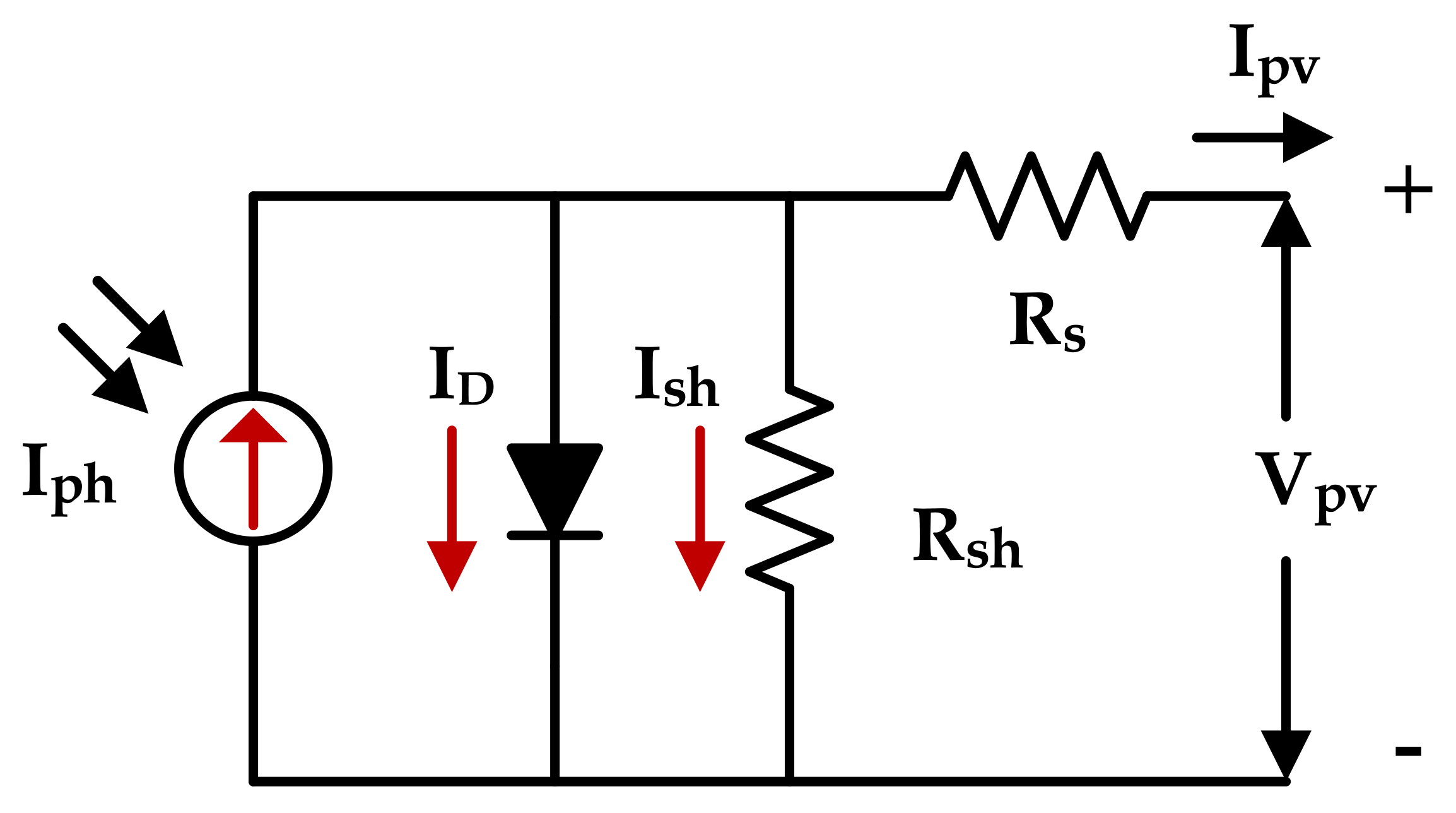
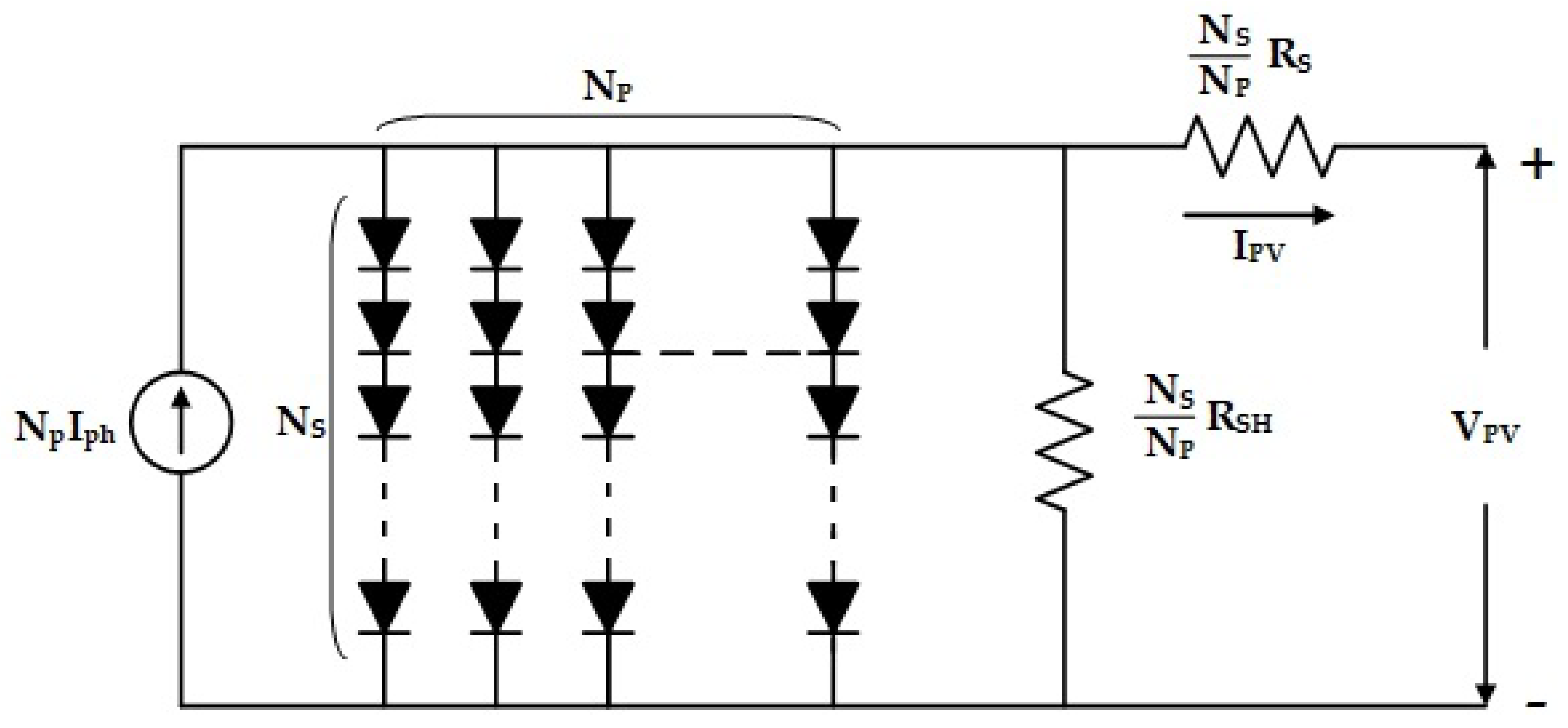
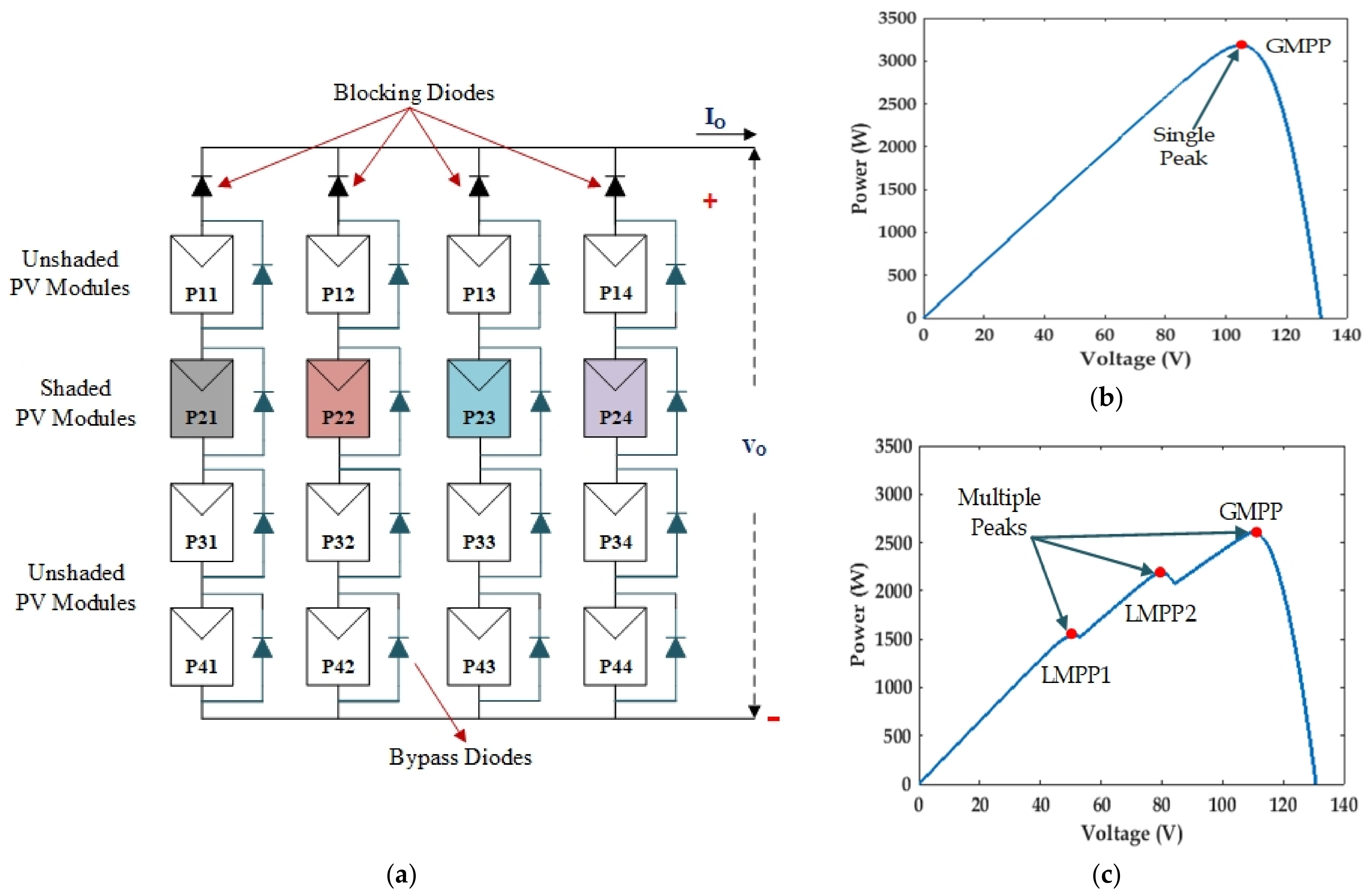
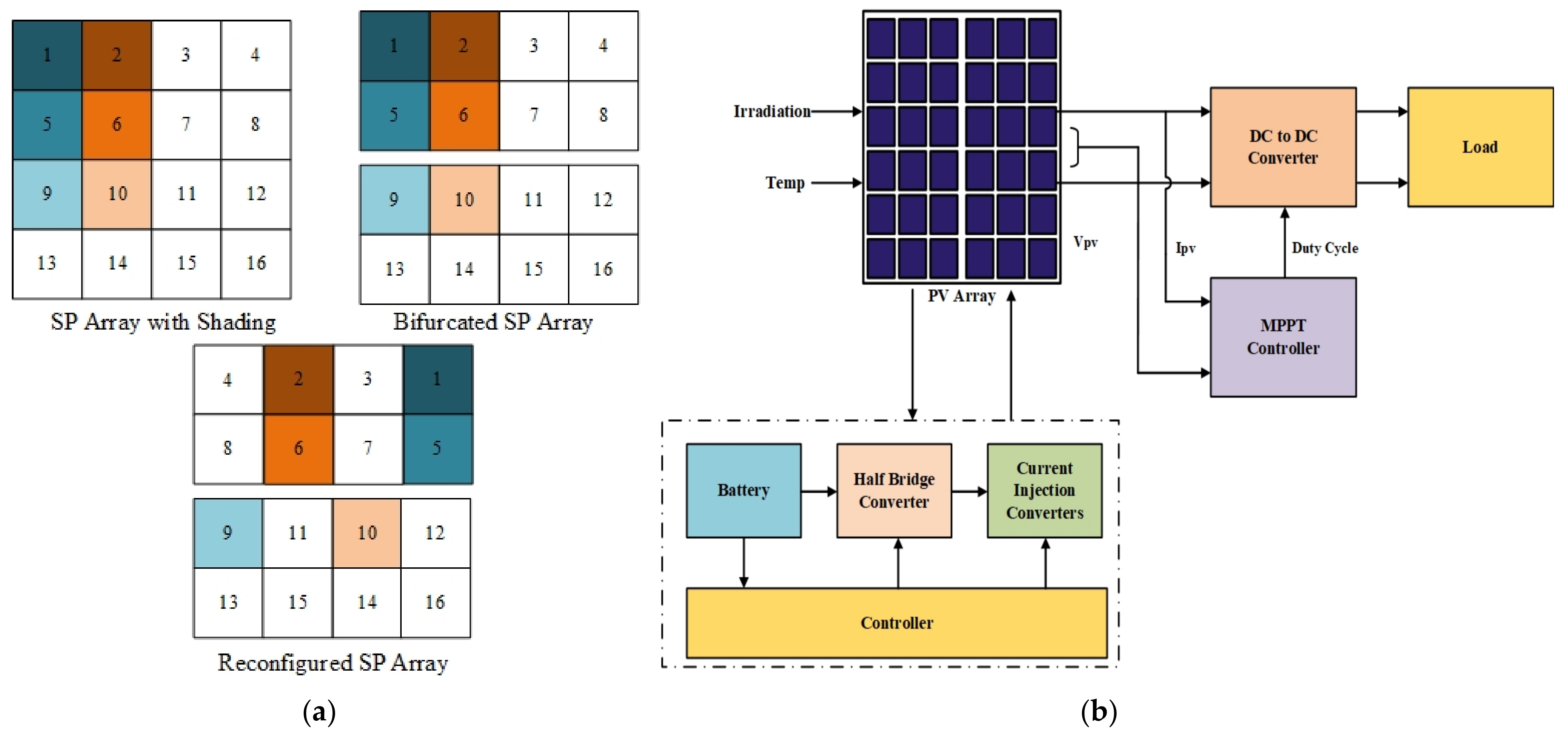
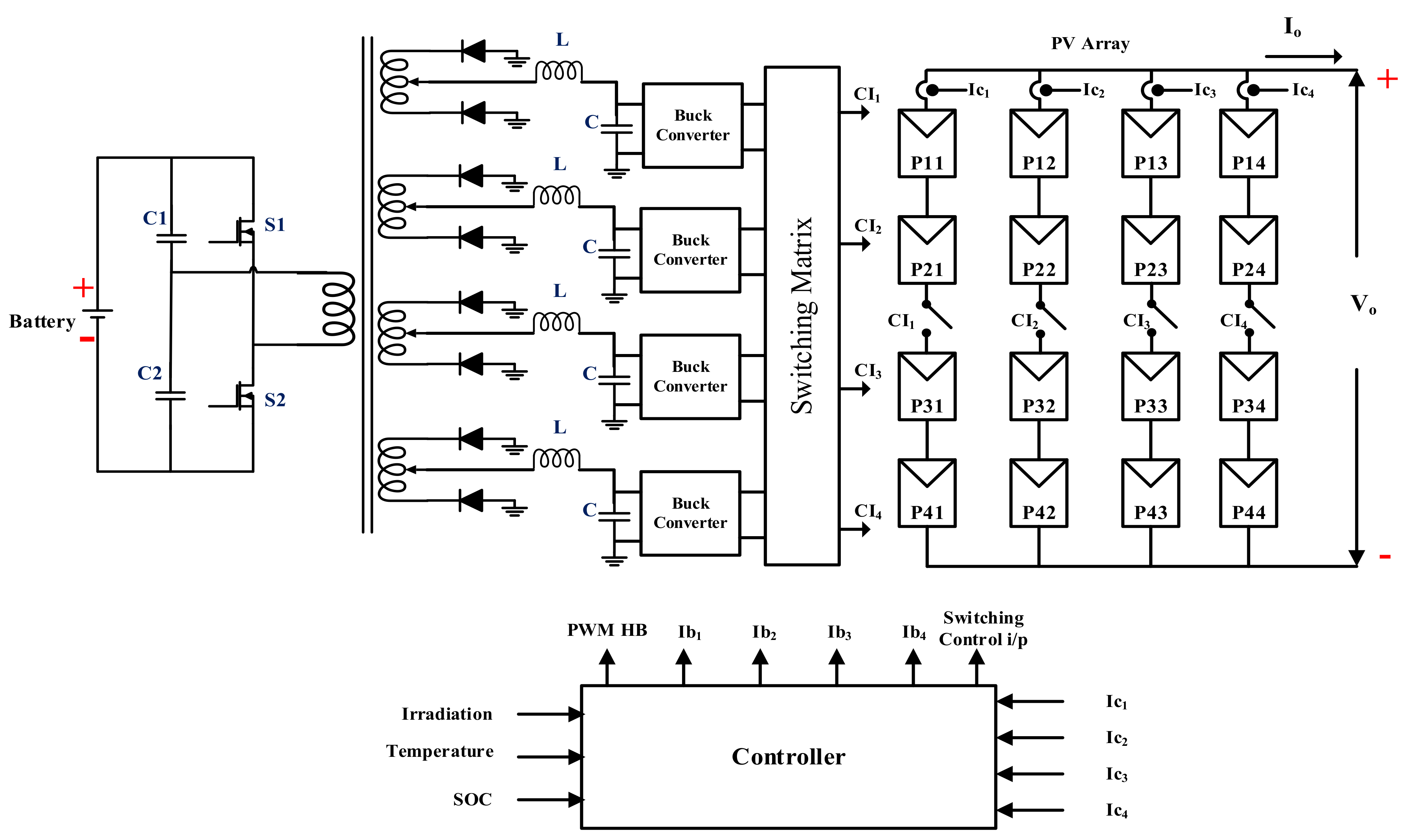
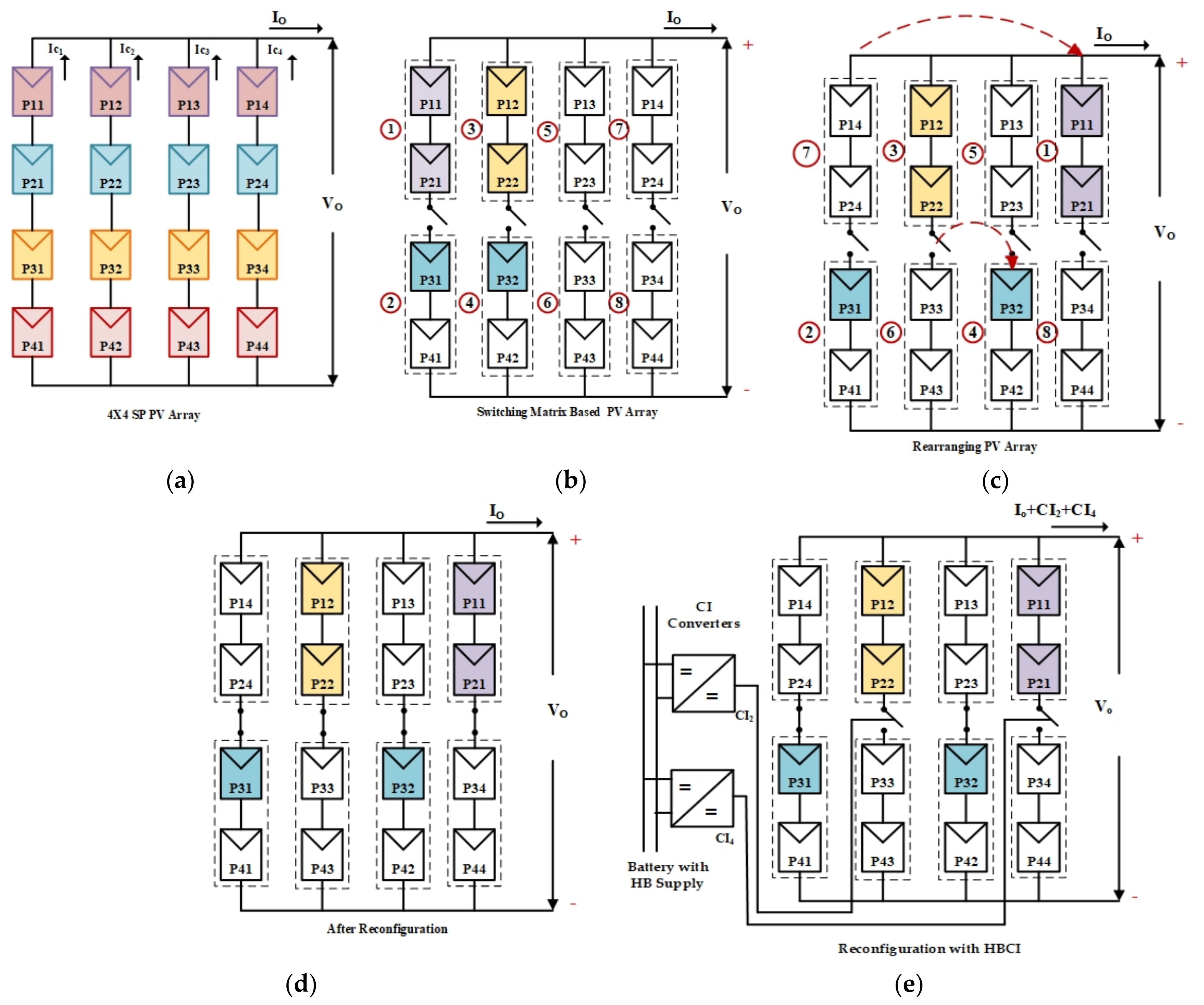
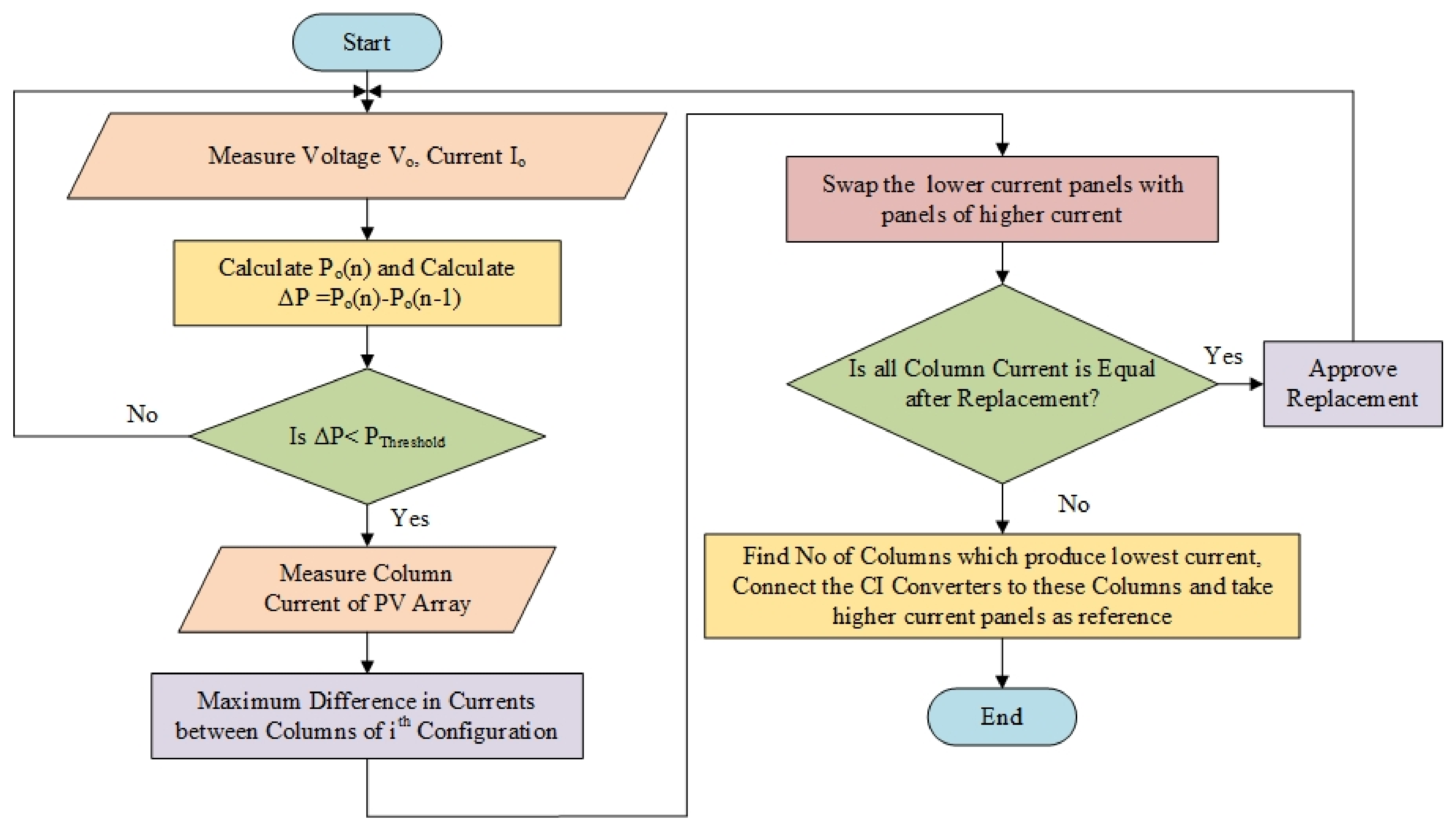
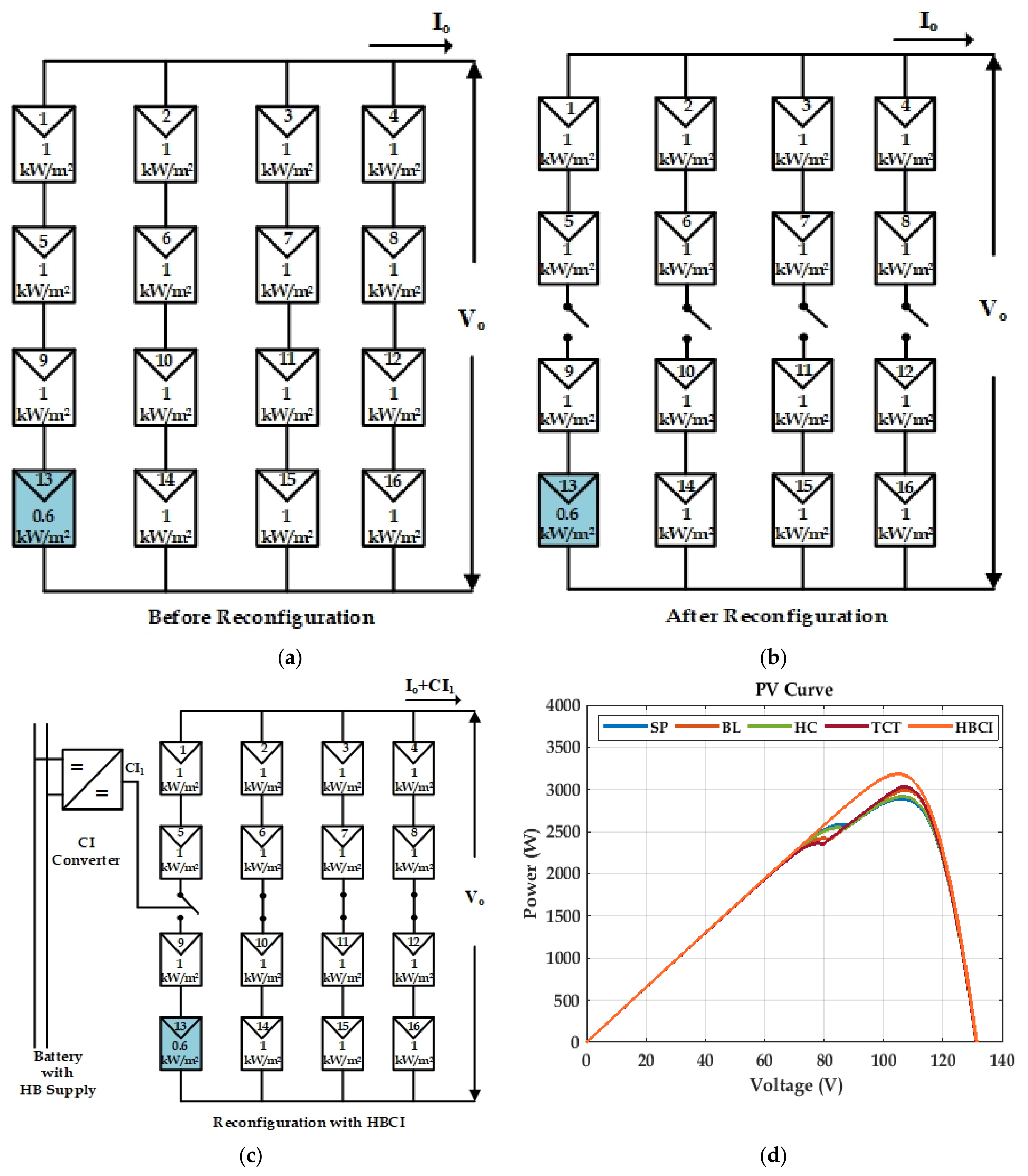
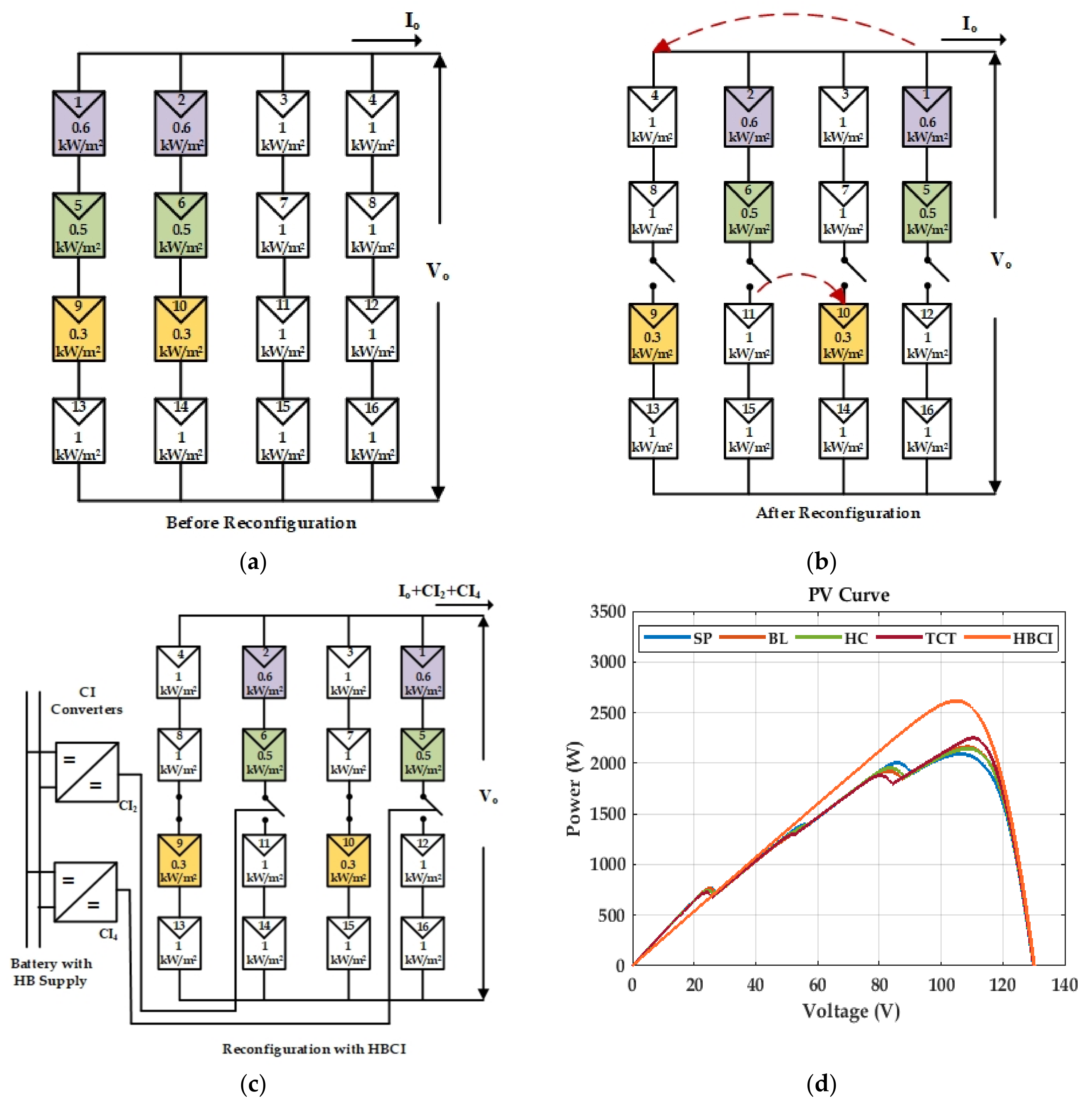
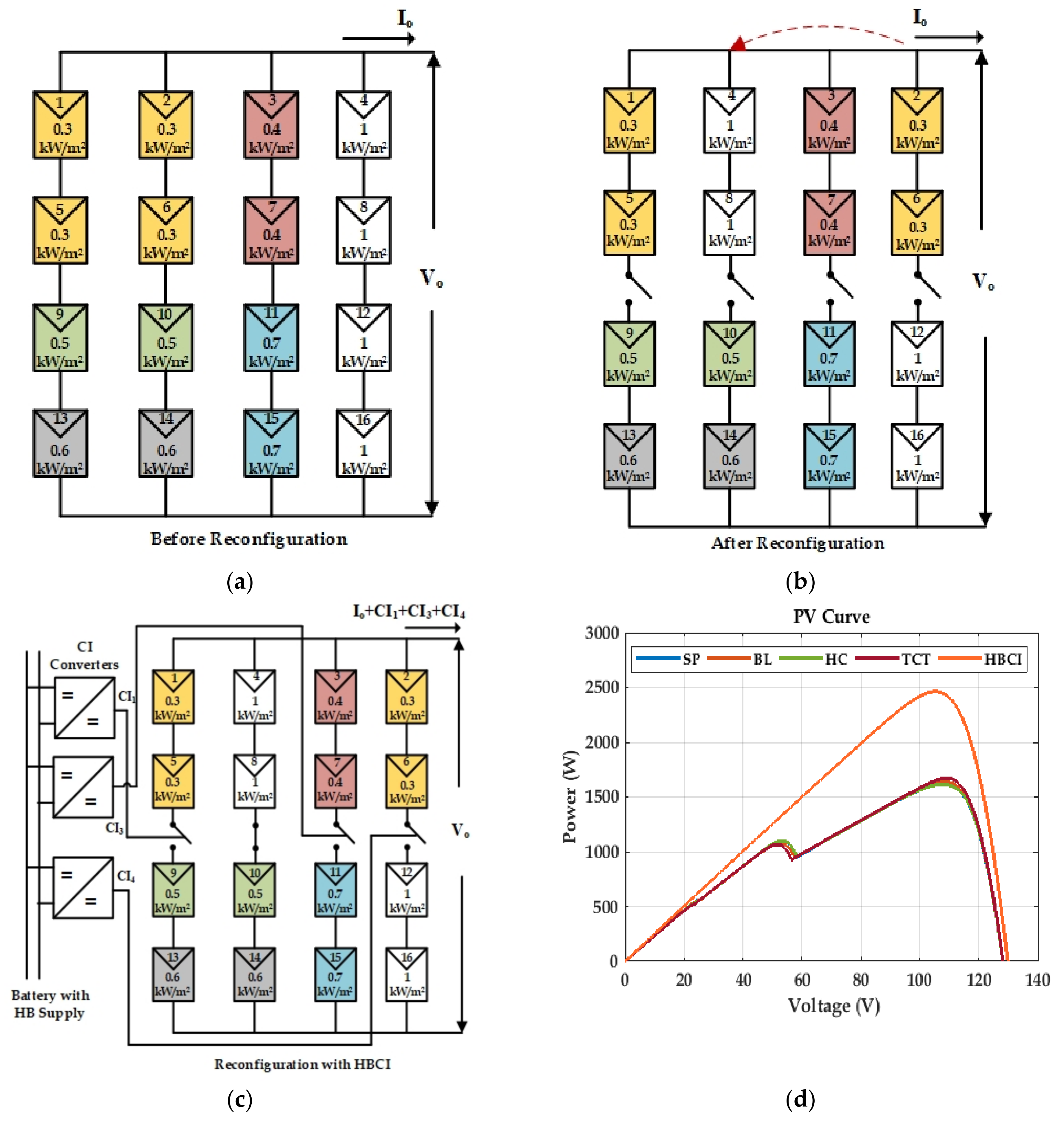
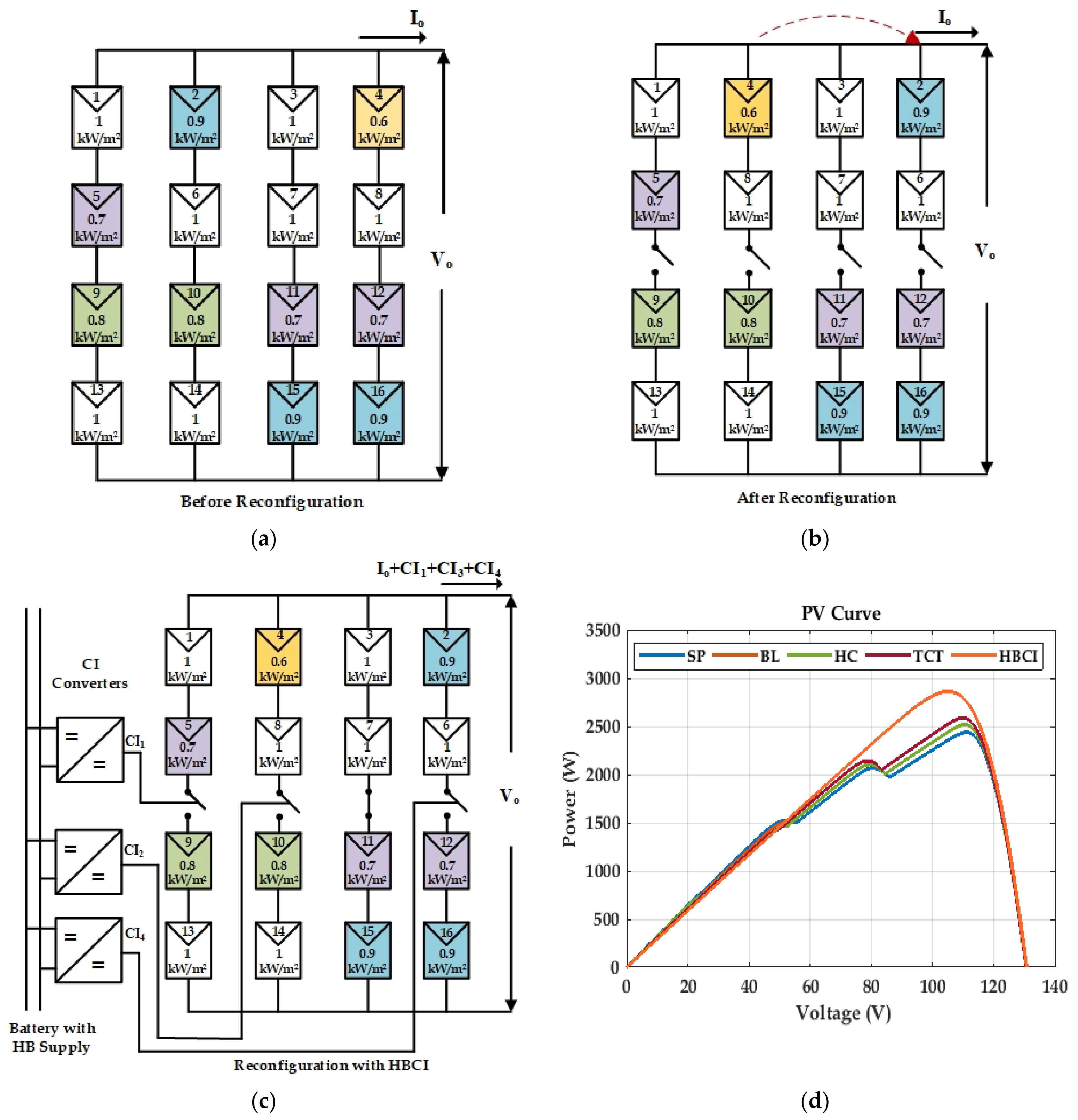
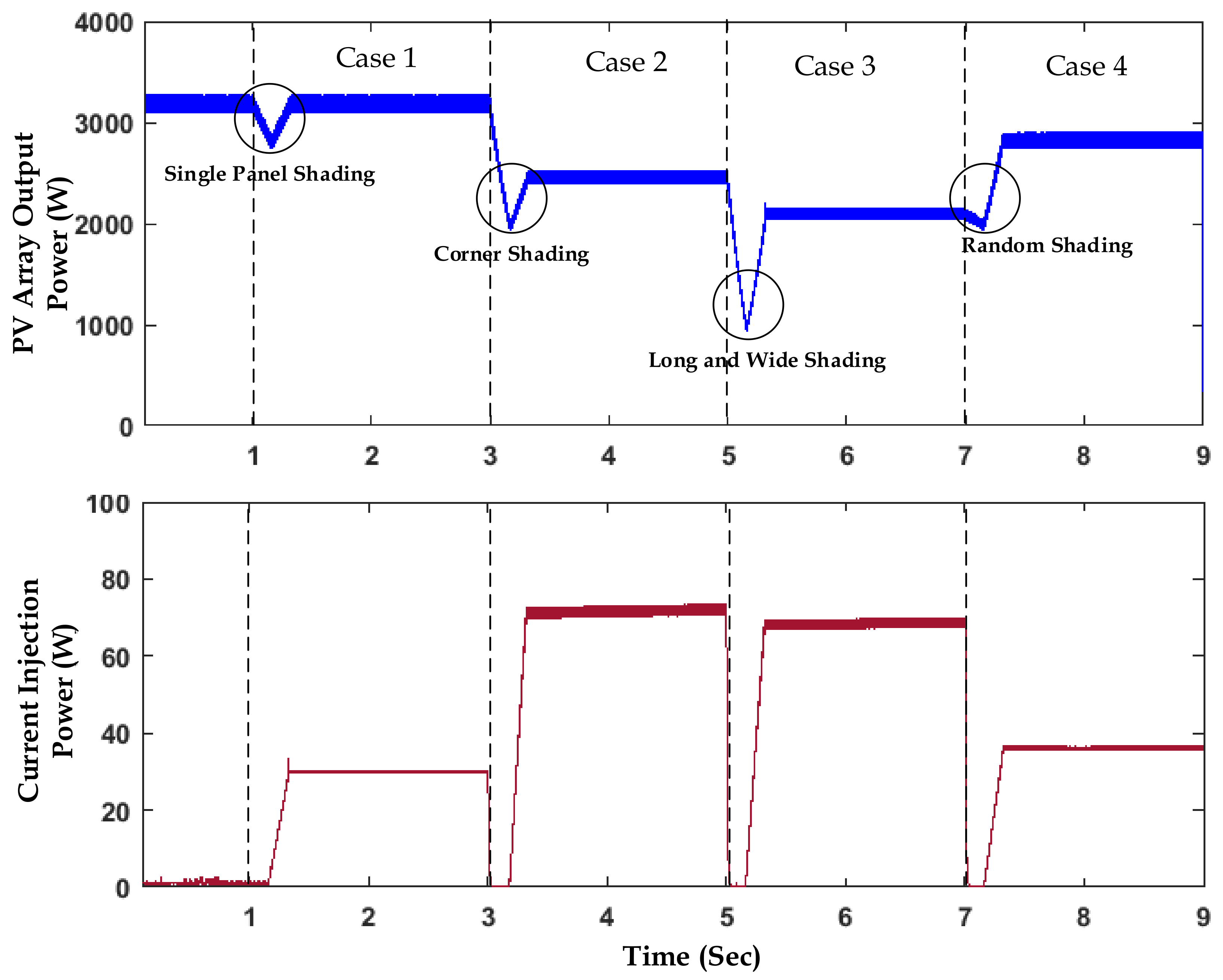

| Specification Parameters | Values |
|---|---|
| Maximum Power (Pmax) | 200.143 W |
| Maximum Power Voltage (Vmp) | 26.3 V |
| Maximum Power Current (Imp) | 7.61 A |
| Open Circuit Voltage (Voc) | 32.9 V |
| Short Circuit Current (Isc) | 8.21 A |
| Temperature Coefficient of Voc | −0.1230 V/K |
| Temperature Coefficient of Isc | 0.0032 A/K |
| Number of Series-Connected Cells in the Module | 54 |
| Configuration | Voc (V) | Isc (A) | Vmp (V) | Imp (A) | Pmp (W) | ∆PL (%) | FF (%) | η (%) |
|---|---|---|---|---|---|---|---|---|
| Series Parallel (SP) | 131.3 | 32.8 | 98.49 | 28.51 | 2807.95 | 12.25 | 65.20 | 12.45 |
| Bridge link (BL) | 131.3 | 32.8 | 99.57 | 28.82 | 2869.607 | 10.32 | 66.63 | 12.72 |
| Honeycomb (HC) | 131.3 | 32.8 | 98.69 | 28.57 | 2819.573 | 11.89 | 65.47 | 12.50 |
| Total Cross Tied (TCT) | 131.3 | 32.8 | 100.1 | 28.98 | 2900.898 | 9.35 | 67.36 | 12.86 |
| HBCI | 131.4 | 32.8 | 105.2 | 30.41 | 3199.132 | 0.03 | 74.23 | 14.18 |
| Configuration | Voc (V) | Isc (A) | Vmp (V) | Imp (A) | Pmp (W) | ∆PL (%) | FF (%) | η (%) |
|---|---|---|---|---|---|---|---|---|
| Series parallel (SP) | 129.9 | 32.7 | 82.5 | 23.88 | 1970.1 | 38.43 | 46.38 | 8.73 |
| Bridge link (BL) | 129.9 | 32.7 | 81.36 | 23.55 | 1916.028 | 40.12 | 45.11 | 8.49 |
| Honeycomb (HC) | 129.9 | 32.7 | 81.96 | 23.72 | 1944.091 | 39.25 | 45.77 | 8.62 |
| Total cross tied (TCT) | 130 | 32.7 | 80.53 | 23.31 | 1877.154 | 41.34 | 44.16 | 8.32 |
| HBCI | 130.2 | 27 | 99.86 | 25.4 | 2536.444 | 20.74 | 72.15 | 11.24 |
| Configuration | Voc (V) | Isc (A) | Vmp (V) | Imp (A) | Pmp (W) | ∆PL (%) | FF (%) | η (%) |
|---|---|---|---|---|---|---|---|---|
| Series parallel (SP) | 128.2 | 23.7 | 57.99 | 16.78 | 973.0722 | 69.59 | 32.03 | 4.31 |
| Bridge link (BL) | 128.2 | 23.7 | 57.56 | 16.66 | 958.9496 | 70.03 | 31.56 | 4.25 |
| Honeycomb (HC) | 128.2 | 23.7 | 57.98 | 16.78 | 972.9044 | 69.60 | 32.02 | 4.31 |
| Total cross tied (TCT) | 128.2 | 23.7 | 56.66 | 16.4 | 929.224 | 70.96 | 30.58 | 4.12 |
| HBCI | 129.9 | 25.4 | 92.12 | 24.78 | 2282.734 | 28.66 | 69.19 | 10.12 |
| Configuration | Voc (V) | Isc (A) | Vmp (V) | Imp (A) | Pmp (W) | ∆PL (%) | FF (%) | η (%) |
|---|---|---|---|---|---|---|---|---|
| Series parallel (SP) | 130.6 | 32.7 | 83.72 | 24.23 | 2028.536 | 36.61 | 47.50 | 9.00 |
| Bridge link (BL) | 130.6 | 31.9 | 82.34 | 24.2 | 1992.628 | 37.73 | 47.83 | 8.83 |
| Honeycomb (HC) | 130.6 | 32.7 | 83.64 | 24.21 | 2024.924 | 36.72 | 47.42 | 8.98 |
| Total cross tied (TCT) | 130.6 | 31 | 84.84 | 24.56 | 2083.67 | 34.89 | 51.47 | 9.24 |
| HBCI | 130.8 | 29.5 | 99.04 | 28.38 | 2810.755 | 12.16 | 72.84 | 12.46 |
| Cases | MPPT without HBCI | MPPT with HBCI |
|---|---|---|
| Case 1 | 2807.95 W | 3199.13 W |
| Case 2 | 1877.15 W | 2536.44 W |
| Case 3 | 929.22 W | 2282.73 W |
| Case 4 | 1992.62 W | 2810.75 W |
| Total | 7606.94 | 10,829.05 |
Publisher’s Note: MDPI stays neutral with regard to jurisdictional claims in published maps and institutional affiliations. |
© 2021 by the authors. Licensee MDPI, Basel, Switzerland. This article is an open access article distributed under the terms and conditions of the Creative Commons Attribution (CC BY) license (https://creativecommons.org/licenses/by/4.0/).
Share and Cite
Vadivel, S.; Boopthi, C.S.; Ramasamy, S.; Ahsan, M.; Haider, J.; Rodrigues, E.M.G. Performance Enhancement of a Partially Shaded Photovoltaic Array by Optimal Reconfiguration and Current Injection Schemes. Energies 2021, 14, 6332. https://doi.org/10.3390/en14196332
Vadivel S, Boopthi CS, Ramasamy S, Ahsan M, Haider J, Rodrigues EMG. Performance Enhancement of a Partially Shaded Photovoltaic Array by Optimal Reconfiguration and Current Injection Schemes. Energies. 2021; 14(19):6332. https://doi.org/10.3390/en14196332
Chicago/Turabian StyleVadivel, Srinivasan, C. S. Boopthi, Sridhar Ramasamy, Mominul Ahsan, Julfikar Haider, and Eduardo M. G. Rodrigues. 2021. "Performance Enhancement of a Partially Shaded Photovoltaic Array by Optimal Reconfiguration and Current Injection Schemes" Energies 14, no. 19: 6332. https://doi.org/10.3390/en14196332
APA StyleVadivel, S., Boopthi, C. S., Ramasamy, S., Ahsan, M., Haider, J., & Rodrigues, E. M. G. (2021). Performance Enhancement of a Partially Shaded Photovoltaic Array by Optimal Reconfiguration and Current Injection Schemes. Energies, 14(19), 6332. https://doi.org/10.3390/en14196332









